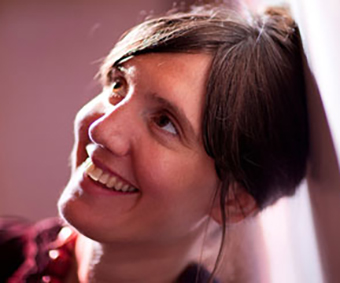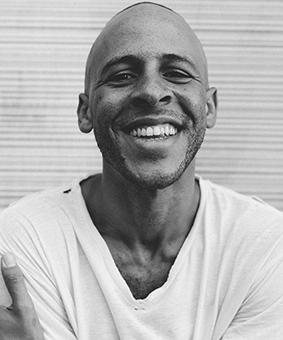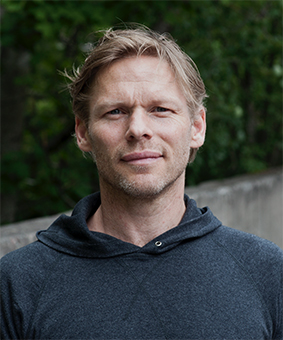How Dance Thinks
Read more and listen to the podcast here.
The pod How Dance Thinks edition holds conversations between Eleanor Bauer and Juliette Mapp, Cecilia Roos, Will Rawls, Michelle Boulé, Rasmus Ölme and Peter Mills.
Edited by Robin Jonsson
Music by Linnéa Martinsson
SKH Dance Podcast
How Dance Thinks is the first edition of the SKH Dance Podcast, a podcast that cherishes the oral tradition in dance and choreography. Despite the vivid discourse around dance, there is relatively little published writing dealing with dance and choreography. In fact, the transfer of knowledge, the debating and sharing in the dance field often happens orally: through conversations, verbal instructions, in workshops, in studios, in after talks and theatre foyers. By welcoming listeners into this audio space, the SKH Dance Podcast series aims to further resonant discussions within the field.
About the the SKH Dance Podcast
Eleanor Bauer
Eleanor Bauer is a performer and choreographer working at the intersections of dance, writing, and music. Her work is a profound synthesis of intelligence. Physical, conceptual, sensual, intellectual, social, formal, and emotional understandings are bound in her embodied practice of making performances. From solos to talk shows to large ensemble pieces, her versatile works range in scale, media, and genre traversing categories of performance with wit, humour, and aplomb.
Originally from Santa Fe, New Mexico, Eleanor is currently based in Stockholm where she is a Doctoral candidate in Choreography at Stockholm University of the Arts. She has been creating performances via GoodMove vzw in Brussels since 2007 and was an artist in residence at Kaaitheater in Brussels from 2013–2016. Together with Ellen Söderhult and Alice Chauchat, Bauer co-founded the open-source format for exchange of practices in the performing arts called Nobody's Business in 2015, which has since been adapted and sustained internationally by myriad practitioners and organizers. Eleanor continues to teach, write, lecture, and create contexts for exchange of knowledge in the arts, including PROTO TALKS.
Eleanor has collaborated with musician and composer Chris Peck since 2003, creating several works together over the years. Eleanor has worked as a performer with, among others, choreographers Xavier Le Roy, Boris Charmatz, Anne Teresa De Keersmaeker/Rosas, Trisha Brown, David Zambrano, Mette Ingvartsen, and Veli Lehtovaara. She has collaborated as a choreographer and performer with visual artists Matthew Barney, and Every Ocean Hughes/Emily Roysdon. She has performed or collaborated with music groups such as Ictus contemporary music ensemble, The Knife (leading Miguel Gutierrez's Deep Aerobics as a crowd-warmer for the Shaking The Habitual/Shaken Up tour), Arjan Miranda, and WATT clarinet ensemble. She choreographed a collaboration between pop artist Yung Lean and Cullbergbaletten called NEAR, which premiered in 2018 at Way Out West music festival in Gothenburg and at Dramaten Theater in Stockholm.
Eleanor Bauer’s research project CHOREO|GRAPHY
CHOREO|GRAPHY is an inquiry into nature (systems, processes, qualities, structures) of thought in improvised and choreographed dance in relation to nature (systems, processes, qualities, structures) of thought in spoken and written language. Or, the relation between what we say we’re doing and what our dance is doing, what is understood through language and what is understood through movement, and how these things collaborate and collide in choreographic practice.
Edition #1 How Dance Thinks, Introduction
Listen to "Episiode 0 DOCH podcast Eleanor & Anna & Robin" on Spreaker.
Introduction to the edition How Dance Thinks with Eleanor Bauer, Doctoral candidate in Choreography at Stockholm University of the Arts, Anna Efraimsson, Head of department of dance at Stockholm University of the Arts (until November 2019) and Robin Jonsson, Choreographer and sound-artist.
Edition #1 How Dance Thinks, episode 1
Listen to "Episode 1- Juliette Mapp" on Spreaker.
Shownotes Juliette Mapp
Juliette wrote ”letting our speech go” for the dancer as agent collection, more information here:
Letting our speech go
The Dancer as Agent Collection

Juliette Mapp is a dancer, choreographer, and curator, who lives and works in Stockholm and New York City. Juliette is currently a professor of choreography at Stockholm University of the Arts where she is responsible for the profile area of Concept and Composition. Juliette has been on the faculty of The Eugene Lang School of Liberal Arts at The New School, Sarah Lawrence College, Barnard College, George Washington University, Fordham University, Bard College, and Wesleyan College. In addition, she is on the faculty at P.A.R.T.S. in Brussels where she is a regular visiting teacher. In 2012, she was a guest curator for the Judson Now platform at Danspace Project and also co-curated Movement Research Fall Festival, Back to Basic that year. In 2010, she curated Back To New York City, a platform at Danspace Project. In 2018, she helped plan and curate Alliances and Commonalities, an international conference on Artistic Research at SKH. Juliette has published articles about her teaching, performing, and choreographic practices in Performing Arts Journal, Contact Quarterly, and The Movement Research Performance Journal. Juliette has danced for many renowned choreographers including Deborah Hay, John Japserse, Vicky Shick, and Stephanie Skura.
Juliette's choreography has been performed and commissioned in theatres throughout New York City. Over the past decade, Juliette has received a Robert Rauschenberg Residency, a MANCC residency, and was twice a Movement Research Artist-in-Residence. In 2008, Juliette won a New York Dance and Performance, i.e. “Bessie” Awards in choreography for her piece Anna, Ikea and I and in 2002 received a Bessie for outstanding artistic achievement for her work as a performer in the choreography of John Jasperse. She is currently working on Soft Lockdown, a research project about the embodiment of moral shock that looks at the practice of live-shooter drills in schools in the United States.
Edition #1 How Dance Thinks, episode 2
Listen to "Episode 2- Will Rawls and Eleanor Bauer" on Spreaker.
In this episode, Eleanor Bauer speaks with Will Rawls about dance as a medium of thought, language thinking and dance thinking among many many other things.
Shownotes Will Rawls
Will mentions ”écriture feminine”, here is more information:
Écriture feminine
More on the aesthetics of kewt:
Relishing the Minor: Juliana Huxtable’s Kewt Aesthetics by Adrienne Edwards

Will Rawls is a New York-based choreographer, performer, curator and writer. His work explores the relationship between dance and language through the prisms of blackness, abstraction and opacity. Will’s choreographic work has appeared at Museum of Modern Art, Museum of Contemporary Art, Chicago; Danspace Project; New Museum of Contemporary Art, Issue Project Room; Hirshhorn Museum and Sculpture Garden; Portland Institute for Contemporary Art; Whitney Museum of American Art; MoMA PS1; Fisher Center at Bard; Abrons Arts Center. In 2016 he co-curated Lost and Found, a six-week program of performances, artist projects and panels at Danspace Project that considered the intergenerational impact of HIV/AIDS on dancers, women and people of colour. His writing has been published by Artforum, the Hammer Museum, the Museum of Modern Art and les presses du réel. He is a recipient of a Guggenheim Fellowship, a Foundation for Contemporary Arts grant, a Robert Rauschenberg Residency and is currently a Hodder Fellow at Princeton University.
Photo by: Luis Rodriguez
Edition #1 How Dance Thinks, episode 3
Listen to "Episode 3 Cilla Roos & Eleanor Bauer" on Spreaker.
In this episode, Eleanor Bauer speaks with Cecilia Roos about hermeneutics and embodied experiences among many things.
Shownotes Cecilia Roos
Cecilia talks about the book ”Material of movement and Thought: Reflections on the Dancer’s Practice and Corporeality” which can be found here:
Material of Movement and Thought: Reflections on the Dancer’s Practice and Corporeality

Cecilia Roos is a Professor in Artistic Practice and Vice-Rector for Research at Stockholm University of the Arts. She has worked as a dancer and rehearser with, among others, Tilde Björfors, John Caird, Cristina Caprioli, Jefta van Dinther, Mats Ek, Ina Christel Johannessen, Per Jonsson, Reich / Szyber, Twyla Tharp, Margaretha Åsberg. Her research is based on the dancer's practise and the role it plays in performative processes.
Edition #1 How Dance Thinks, episode 4
Listen to "Episode 4- Rasmus Ölme and Eleanor Bauer" on Spreaker.
In this episode, Eleanor Bauer speaks with Rasmus Ölme about how language conditions the dance, complexity of rules, simplicity of outcomes among other things.

After a career as a dancer, then based in Brussels, Rasmus Ölme formed REFUG to produce choreographic works. Starting in 2001 with his debut This is not a Test Rasmus produced and toured 5 productions across Europe until he shifted his base to Stockholm, and in 2008 started as a PhD candidate at Stockholm University of the Arts in collaboration with KTH (Royal Institute of Technology). During the PhD project, he formed the research group Svärmen (the Swarm) and produced 6 serial works under the name MODUL 1-6. In 2014 he successfully defended his thesis From Model to Module – a move towards generative choreograph and in 2015 he started as head of programme for the Dance and Choreography programme at DASPA (Danish National School of Performing Arts). During 2016-2018 he received a research grant from the Danish Culture Ministry for the research project Movement Material. In 2019 Rasmus was appointed professor at DASPA where in fall 2020 he will head the new MFA in choreography at DASPA. Next to the position at DASPA Rasmus is a frequent guest teacher and lecturer at universities and other institutions of Western staged contemporary dance.
Photo by: Nicklas Dennermalm
Edition #1 How Dance Thinks, episode 5
Listen to "Episode 5 - Peter Mills and Eleanor Bauer" on Spreaker.
In this episode, Eleanor Bauer speaks with Peter Mills about putting the dance from your shower on stage, choreography vs dance and many other things.

Peter Mills, better known as PETER (Stateless), who defines art as that which facilitates a space, a gap within the system, within social norms, which produces a dubitability of the state of things and allows a collective of persons to silently agree, not presume, assume or count on, but expect difference. PETER creates spaces which expand the creative process from initiation to documentation, by use of fundamental methods investigating the emergence of choice, perception and action, to refine the creative process by facilitating individual definitions, which are attuned to a subjective interpretation of a situation, providing direct democracy, action and agency.
Edition #1 How Dance Thinks, episode 6
Listen to "Episode 6 - Michelle Boulé and Eleanor Bauer" on Spreaker.
In this episode, Eleanor Bauer speaks with Michelle Boulé about body talk, healing practices and the gut brain, among many other things.

Michelle Boulé is a New York-based dance artist, teacher, life coach, and energy medicine practitioner. Her research in energy work, somatic practices, and mindset/psychology provide the framework from which she dances, teaches, and makes dances, with a desire to create aesthetically enlivened experiences that remind us of the potential of what and who we are. Boulé’s most recent commissions, presentations, and awards have come from The Chocolate Factory, Danspace Project, Triple Canopy, Baryshnikov Arts Center, Summer Stages Dance @ICA Boston, The Met Breur (with Okkyung Lee), University of Illinois Distinguished Legacy Award, New York Foundation for the Arts Choreography Fellowship, Lower Manhattan Cultural Council’s Extended Life Dance Development Program, and the MacDowell Colony. She is a “Bessie” Award-winning performer, and she teaches internationally and has maintained a healing/coaching practice since 2008. website: michelleboule.com
Correction: Michelle first experienced BodyTalk in 2007 and became a Certified BodyTalk Practitioner in 2008. (In the interview she said she encountered it in 2009).
Footnote to the notion of "heart field”:
"The heart, like the brain, generates a powerful electromagnetic field," McCraty explains in The Energetic Heart. “The heart generates the largest electromagnetic field in the body. The electrical field as measured in an electrocardiogram (ECG) is about 60 times greater in amplitude than the brain waves recorded in an electroencephalogram (EEG).” Source: https://www.heartmath.org/articles-of-the-heart/science-of-the-heart/the-energetic-heart-is-unfolding/, 2010.
SKH Dance Podcast is launched by the Department of Dance at Stockholm University of the Arts.